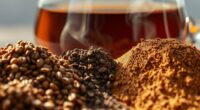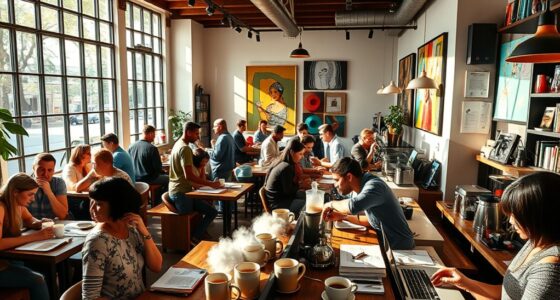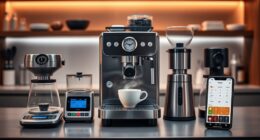Coffee drinking in America has evolved considerably over the centuries. From its introduction in the 17th century as a patriotic symbol during the Revolution, it became a staple for soldiers in the Civil War. The Great Depression saw coffee as a comfort for many, while diner culture popularized bottomless cups. Later, specialty coffee emerged, emphasizing quality and unique flavors. Today, coffee is a daily ritual intertwined with social identity. There’s much more to explore about this fascinating journey.
Key Takeaways
- Coffee was introduced to America in 1668 and became a patriotic symbol following the Boston Tea Party in 1773.
- During the Civil War, coffee became essential for soldiers, leading to increased importation and creative substitutes due to shortages.
- In the late 19th and early 20th centuries, coffeehouses evolved into social hubs, fostering political discourse and community engagement.
- The second wave of coffee culture in the late 1970s emphasized quality and consumer experience, leading to the rise of specialty coffee shops.
- Today, nearly 64% of Americans drink coffee daily, with a focus on unique flavors and sustainable sourcing in contemporary coffee culture.
Early History of Coffee in America
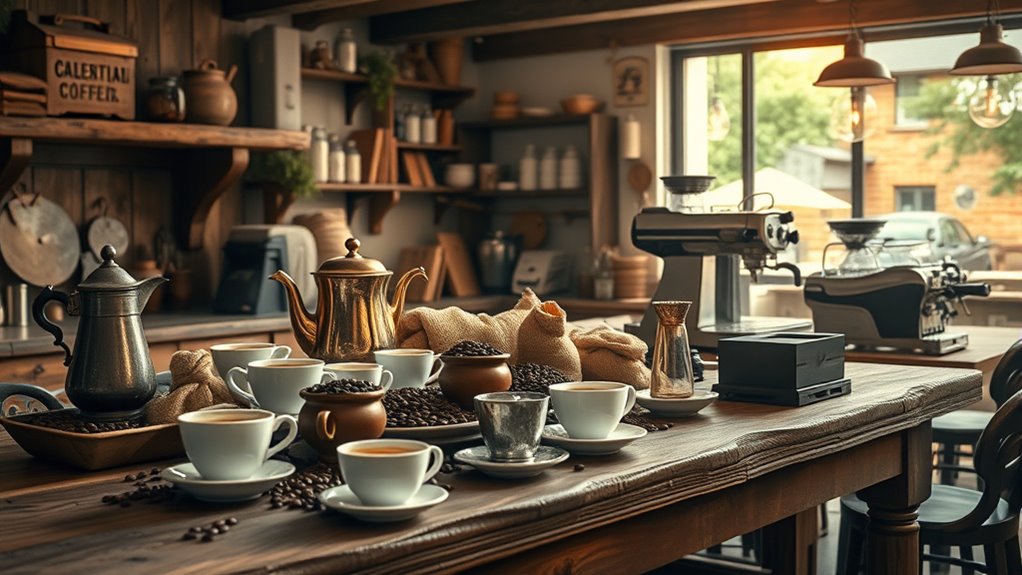
Coffee made its debut in America thanks to Captain John Smith, who brought the beverage back from Turkey, with the first recorded mention of it occurring in 1668 in New Amsterdam. This marked the beginning of coffee’s journey through American history.
Captain John Smith introduced coffee to America in 1668, marking the start of its rich history in the nation.
In 1670, Dorothy Jones obtained the first coffee license in Boston, paving the way for coffeehouses to emerge in New England by the mid-1770s. These establishments became social hubs where people gathered to enjoy the drink.
As the Boston Tea Party in 1773 shifted preferences, coffee became the patriotic choice for Americans. By the mid-1800s, coffee bean roasting started, enhancing its flavor.
This early history laid the groundwork for coffee’s enduring popularity in America.
The American Revolution and Coffee’s Rise
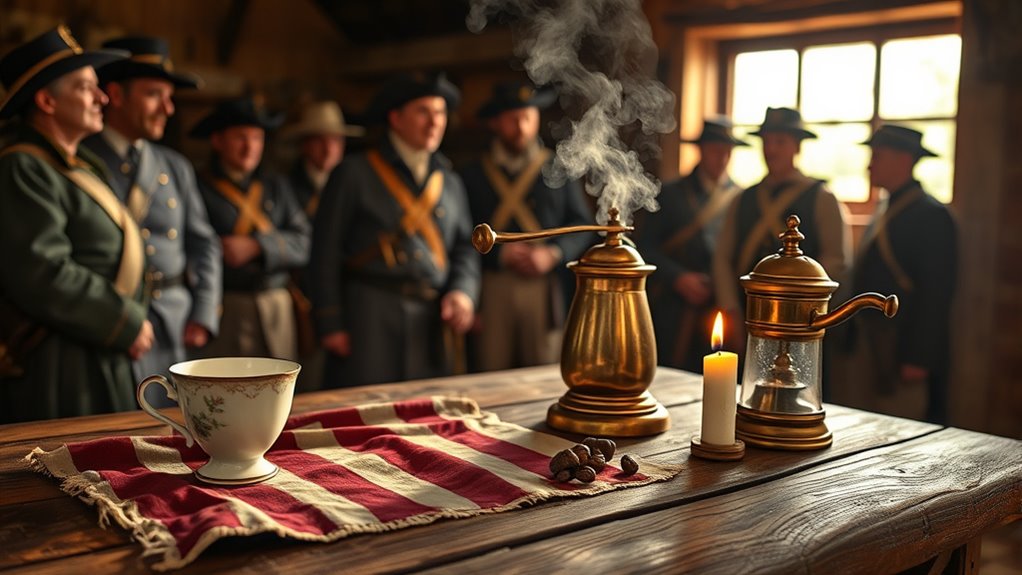
During the American Revolution, sipping tea became a sign of loyalty to Britain, pushing many patriots to embrace coffee instead.
The Boston Tea Party marked a turning point, making coffee the go-to drink in protest of British taxes.
As coffeehouses sprang up in New England, they became vibrant centers for discussions about independence and patriotism.
Coffee vs. Tea Debate
Why did coffee emerge as the beverage of choice during the American Revolution? As loyalty to Britain became synonymous with drinking tea, many American patriots turned to coffee as a symbol of independence.
The Boston Tea Party in 1773 was a pivotal moment, igniting a shift toward coffee as a form of protest against British taxation. By the mid-1770s, coffee consumption soared, reflecting a growing coffee culture that defined American identity.
Coffeehouses, like the London Coffee House established in Boston in 1669, transformed into essential social hubs, where discussions about freedom and revolutionary ideas flourished.
For many, choosing coffee over tea wasn’t just about taste; it was a powerful statement of defiance and patriotism during the American Revolution.
Political Coffeehouses Emergence
As the American Revolution unfolded, coffeehouses quickly became essential centers for political discourse and camaraderie among patriots.
During this time, drinking coffee became a patriotic act, as tea was seen as un-American due to its ties with British taxation. Establishments like the London Coffee House in Boston flourished, offering coffee drinkers a space to gather and debate revolutionary ideas.
These political coffeehouses shaped public opinion, fostering a cultural shift away from British customs. By the late 1770s, coffee had firmly replaced tea as the beverage of choice, symbolizing a collective stand against British rule.
The political affiliations of these coffeehouses often influenced their patronage, cementing their role in the fight for independence.
Patriotism and Coffee Consumption
While the American Revolution ignited a surge of patriotic fervor, it also transformed coffee into a symbol of national identity.
Drinking tea became synonymous with loyalty to Britain, so patriots sought alternatives, turning to coffee as their drink of choice. The Boston Tea Party in 1773 was a pivotal moment, reinforcing coffee’s status as a symbol of resistance against British tea taxes.
Coffeehouses blossomed as gathering places where you could engage in spirited discussions about revolution and strategy.
Significantly, George Washington embraced coffee, even importing beans to guarantee a steady supply.
Coffee in the Civil War Era

During the Civil War, coffee became an essential part of soldiers’ rations, providing the energy needed to face the challenges of battle.
You might be surprised to learn that coffee consumption skyrocketed, with troops relying on it to boost their morale.
As supplies dwindled, creativity led to coffee being mixed with chicory or tree bark, highlighting its significance in the daily lives of soldiers.
Coffee as Soldier Ration
Coffee quickly became a staple in soldier rations during the Civil War, with the annual importation skyrocketing from 12 million to over 38 million pounds.
Both Union and Confederate forces relied on coffee as a significant source of energy, replacing alcohol as their preferred stimulant. Soldiers often faced shortages, leading to bitter brews mixed with chicory or even tree bark. This harsh reality didn’t diminish coffee’s importance; it remained a critical part of daily life on the battlefield.
The Union naval blockade severely restricted supplies in the South, prompting creative trades between troops. Despite challenges, coffee’s role in soldier’s rations proved essential, keeping troops awake and alert during long campaigns, making it a true wartime necessity.
Impact on Morale
As soldiers faced the grim realities of the Civil War, the presence of coffee in their rations proved essential for maintaining morale. Coffee became a preferred stimulant, replacing rum and brandy, and providing much-needed energy amidst harsh conditions.
Here are some key points about coffee’s impact on soldiers:
- Coffee supplies increased from 12 million to over 38 million pounds annually, showcasing its importance.
- Union troops often brewed bitter coffee, sometimes mixed with chicory, highlighting their determination to maintain caffeine intake.
- The Union naval blockade limited Southern coffee access, emphasizing its significance for morale.
- Coffee trade between Union and Confederate forces highlighted its role in fostering camaraderie among soldiers.
In these trying times, coffee truly became a lifeline for soldiers endeavoring to keep spirits high.
The Impact of the Great Depression on Coffee Consumption

While the Great Depression plunged millions into economic despair, coffee emerged as an essential source of comfort and sustenance. During this challenging time, coffee became a staple distributed through food banks and soup kitchens, often served with donuts to provide affordable sustenance.
Its low price made coffee a favored choice among those struggling financially, greatly boosting its consumption across major cities. As luxury goods fell out of favor, people turned to this humble beverage, reinforcing its role as a comforting and energizing drink amid hardship.
More than just a beverage, coffee symbolized community support, bringing people together in coffee shops and homes, fostering resilience and hope during a time of uncertainty.
The Evolution of Diner Coffee

Here are some key aspects of diner coffee culture:
- Bottomless Cups: You can enjoy endless refills, making conversations flow easily.
- Consistent Brewing: Automatic filter machines guarantee you get the same great taste every time.
- Cultural Icon: By the mid-20th century, diner coffee symbolized American dining alongside classic fare like eggs and bacon.
- Foundation for Specialty Coffee: The rise of diner coffee paved the way for the specialty coffee shops that emerged in the late 1970s.
- Diner coffee’s popularity contributed to the rise of specialty coffee culture, influencing how Americans perceive and consume coffee today.
The Birth of Coffee Shops in America

Diner coffee laid the groundwork for a broader coffee culture that emerged in America, leading to the rise of coffee shops.
The first coffeehouse, established in Boston in 1669, marked the beginning of vibrant social hubs where people gathered to discuss ideas, especially after the Boston Tea Party in 1773 shifted preferences from tea to coffee.
By the mid-1700s, coffeehouses flourished, becoming essential meeting spots for political discourse.
As prices dropped and the railroad expanded in the late 19th and early 20th centuries, coffee shops became accessible to everyone.
Iconic coffee shops, like Caffe Reggio in New York City, introduced espresso and cappuccino, shaping the coffee shop culture that’s recognized today.
The Second Wave of Coffee Culture

As the late 1970s rolled in, coffee culture in America underwent a transformative shift, emphasizing quality and the overall consumer experience. This second wave of coffee brought new life to coffee shops, turning them into social hubs where you could savor the nuances of different brews.
Major brands like Starbucks and Peet’s Coffee pioneered this movement, creating inviting spaces for you to experiment with various beverages.
Here are four key features of this era:
- Focus on high-quality coffee and sourcing.
- Emergence of specialty coffee, highlighting unique flavors.
- Coffee shops as community gathering spots.
- Enhanced consumer awareness of the coffee supply chain.
You began to appreciate coffee not just as a drink, but as an experience. This movement also led to a greater understanding of the mechanics of French press, which enhanced the brewing experience for many enthusiasts.
The Emergence of Specialty Coffee

With the rise of specialty coffee in the late 1970s, you started to notice a shift in how coffee was perceived and enjoyed.
Erna Knutsen popularized the term, emphasizing high-quality, single-origin coffees that transformed coffee culture. This shift laid the groundwork for the second wave, where brands like Starbucks created inviting spaces for coffee lovers.
As the third wave emerged in the 2010s, you saw a focus on light roasting techniques, highlighting the unique flavors of beans.
Today, consumers crave complexity and quality, seeking out gourmet options rather than traditional dark roasts.
This evolution showcases your growing appreciation for the art of coffee, as specialty coffee becomes an essential part of your daily ritual and social experience.
Contemporary Trends in Coffee Drinking

Today, nearly 64% of American adults enjoy coffee daily, making it a staple in modern life. The contemporary coffee culture has transformed how you experience this beloved beverage.
Here are some trends that define today’s coffee scene:
- Gourmet Coffee: About 61% of you’re indulging in premium coffee experiences, seeking unique flavors and artisan brews.
- Cold Brew Coffee: This invigorating option has captured the attention of over a third of Americans, especially those under 40.
- Diverse Coffee Drinks: You’re exploring an array of creative coffee drinks, from nitro brews to seasonal flavors.
- Sustainable Sourcing: Quality and sustainability matter more than ever, as you prioritize ethically sourced beans in your daily cup.
- Global Coffee Culture: With the rise of specialty coffee shops, you are now more aware of coffee consumption variations across different cultures.
Embrace these trends to enhance your coffee journey!
Social and Cultural Significance of Coffee

Coffee’s journey in America goes beyond just a morning ritual; it’s a symbol of patriotism that emerged during the American Revolution.
As coffee shops evolved into social hubs in the late 19th century, they became essential spaces for connection and community.
Today, coffee continues to shape social interactions, reflecting both cultural identity and collective experiences. The rise of local roasters has further transformed coffee culture, emphasizing unique flavors and community support.
Coffee as Patriot Symbol
As tensions brewed during the American Revolution, people turned to coffee as a symbol of patriotism, rejecting tea due to its ties with British taxation. This shift marked coffee as the drink of choice for many colonists, especially after the Boston Tea Party.
Here are four key reasons coffee became a patriotic symbol:
- Protest Against Taxation: Drinking coffee was a direct rejection of British rules.
- Political Coffeehouses: These venues became hubs for discussing independence and governance.
- Iconic Figures: George Washington embraced coffee, further elevating its status.
- Cultural Identity: Coffee evolved into an unofficial national beverage, especially during the Civil War.
Ultimately, coffee not only fueled conversations but also united people in their quest for freedom.
Social Hub Evolution
While the landscape of coffee consumption has changed dramatically over the centuries, its role as a social hub has remained essential to American culture.
Coffeehouses first emerged in the 17th century, becoming popular meeting spots for patriots during the American Revolution. By the late 19th century, coffee shops became accessible to everyone, thanks to lower prices and the expansion of railroads.
The rise of diners in the early 1900s solidified coffee’s place in American dining culture. Then, the second wave of coffee culture in the late 1970s transformed coffee shops into inviting spaces for community engagement.
Today, modern coffee culture reflects both social identity and personal preference, with coffee shops serving as vibrant social hubs and performance spaces.
Frequently Asked Questions
When Did Drinking Coffee Become Popular in America?
Drinking coffee became popular in America around the mid-1700s. You’ll find that its rise coincided with the growing establishment of coffeehouses, especially in New England.
After the Boston Tea Party in 1773, many Americans turned to coffee as a patriotic alternative to tea. By the time of the Civil War, coffee’s popularity surged even more, becoming a staple for soldiers and solidifying its status as a beloved beverage across the nation.
What Is the Coffee Culture in the United States?
In the United States, coffee culture thrives as a daily ritual for millions.
You find coffee shops on nearly every corner, serving as social hubs where friends gather and coworkers take breaks.
With a rich variety of specialty brews, you can explore diverse flavors and brewing methods.
Whether you’re sipping a classic black coffee or indulging in a frothy latte, it’s clear that coffee has become an integral part of American life and community.
Did American Colonists Drink Coffee?
You might think American colonists were drowning in tea, but they actually embraced coffee with open arms!
By the late 17th century, you’d find them sipping coffee, especially after the Boston Tea Party made tea seem downright unpatriotic.
Coffeehouses popped up in New England, buzzing with revolutionary ideas.
It became a beloved drink, fueling soldiers during the Civil War and helping shape the nation’s taste for this energizing beverage.
Why Do Americans Drink so Much Coffee?
You drink so much coffee because it energizes you and keeps you alert throughout your busy day.
The rich flavors and variety of options make it a delightful experience. Plus, coffee’s social aspect connects you with friends and colleagues, turning a simple cup into a shared moment.
With coffee shops everywhere, it’s easily accessible, fitting seamlessly into your daily routine.
Conclusion
As you’ve seen, coffee’s journey in America is rich and varied, reflecting broader social changes. Did you know that, on average, Americans consume about 3.1 cups of coffee per day? That’s a lot of caffeine fueling conversations, creativity, and community! From the early days of the revolution to today’s specialty brews, coffee remains a beloved ritual. So, next time you sip your favorite cup, remember you’re part of a long-standing tradition that connects millions.

